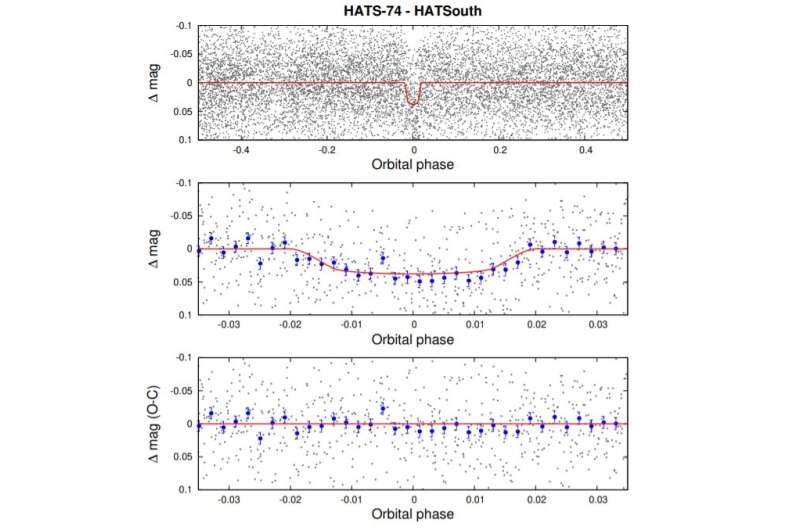Phase-folded unbinned HATSouth light curve of HATS-74A. Credit: Ibáñez et al., 2021.
An international team of astronomers reports the detection of four new giant alien worlds as part of the HATSouth photometric survey. The newfound exoplanets are the size of Jupiter and received designations HATS-74Ab, HATS-75b, HATS-76b and HATS-77b. The finding was detailed in a paper published December 3 on arXiv.org.
HATSouth is a network of six astrograph telescope systems located in South America, Africa, and Australia. These telescopes are designed to detect transiting extrasolar planets in orbit around relatively bright stars visible from the Southern hemisphere. Since its launch in 2009, the network has already detected dozens of transiting exoplanets.
Now, a team of astronomers led by Andres Jordan of Adolfo Ibáñez of the University in Santiago, Chile, reports the finding of new extrasolar planets using HATSouth telescopes. They found transit signals in four stars, namely: HATS-74A, HATS-75, HATS-76 and HATS-77. Afterward, the planetary nature of these signals was confirmed by follow-up observations using NASA's Transiting Exoplanet Survey Satellite (TESS) and ground-based facilities.
"In this work, we present the discovery of four giant planets around early M and late K dwarfs with stellar masses in the range 0.6−0.65 M, a result of a systematic effort to discover giant planets around low mass stars exploiting the synergies between TESS and ground-based surveys," the researchers wrote in the paper.
According to the study, HATS-74Ab is about the size of Jupiter but some 46 percent more massive than the solar system's biggest planet. It orbits its host star every 1.73 days, at a distance of 0.024 AU from it, and has an equilibrium temperature of 895 K. The parent star is about 11 billion years old, has a radius of approximately 0.57 solar radii, mass of around 0.6 solar masses, and has an effective temperature of 3,777 K. The observations show that HATS-74A has a stellar companion, designated HATS-74B, which is estimated to be about 80 percent less massive than the sun. The system is located 934 light years away.
With a radius of about 0.88 Jupiter radii and a mass of only 0.49 Jupiter masses, HATS-75b is the smallest and least massive exoplanet out of the newly detected four. It has an orbital period of approximately 2.79 days and is separated by 0.032 AU from its parent star. The astronomers have calculated that the planet's equilibrium temperature is 772.3 K. At a distance of some 637 light years away from the Earth, the host HATS-75 is nearly 15 billion years old, has a radius of 0.58 solar radii and its mass is estimated to be 0.6 solar masses. The star has an effective temperature at a level of 3,790 K.
HATS-76b orbits its host every 1.94 days, at a distance of 0.026 AU from it, and turns out to be the hottest planet out of the newly found quartet—with an equilibrium temperature of 939.8 K. The exoplanet is about 2.63 times more massive than Jupiter and its radius is estimated to be approximately 1.08 Jupiter radii. HATS-76 has a mass of 0.66 solar masses, radius of 0.62 solar radii, and effective temperature of about 4,016 K. The star, located 1,271 light years away, is relatively young when compared to the other three hosts described in the paper—its age is estimated to be 4.6 billion years.
When it comes to HATS-77b, this alien world is about 16 percent larger and 37 percent more massive than Jupiter. The exoplanet's orbital period is nearly 3.09 days and circles its parent star at a distance of around 0.036 AU from it. The equilibrium temperature of HATS-77b was found to be 828.3 K. The stellar host is 12.1 billion years old, is approximately 35 percent smaller and less massive than the sun, and its effective temperature was measured to be 4,071 K. The distance to this planetary system is estimated to be 1,349 light years.
More information: A. Jordán et al, HATS-74Ab, HATS-75b, HATS-76b and HATS-77b: Four Transiting Giant Planets around K and M Dwarfs. arXiv:2112.01928v1 [astro-ph.EP], arxiv.org/abs/2112.01928
© 2021 Science X Network
























